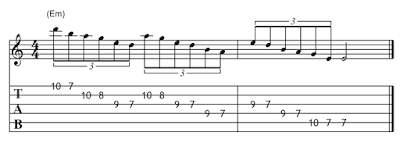Do This Scale First Thing Every Morning (INSTANT SOLOS!)
When you wake up tomorrow, set aside just 5 min. and do this simple Pentatonic Scale Sequencing Exercise. I guarantee that you will start to feel an amazing fresh connection to how you approach your soloing ideas from that day forward...
If you're feeling as though your solos are boring or that they lack phrasing, then you have come to the right video. Here I’m going to show you how one simple Pentatonic Scale Sequencing Exercise can make a serious difference to how you play lead.
If you're feeling as though your solos are boring or that they lack phrasing, then you have come to the right video. Here I’m going to show you how one simple Pentatonic Scale Sequencing Exercise can make a serious difference to how you play lead.
If you make this exercise the first thing that you do every single morning for the next three weeks you'll notice that your solos will start to tighten up so that anytime you set out to perform a new solo, you'll have fresh ideas in just seconds.
When you wake up in the morning, do you have about 5 min. that you could devote to playing a scale idea that will help to get yourself going with producing more melody in your guitar solos almost instantly?
If you think that you can fit this in and do it every morning for about the next three weeks, I guarantee you – that you’ll start to discover new lines and new soloing concepts that will help you to push you guitar playing into brand new directions.
On top of all that, you’ll notice that sequencing ideas will have a serious impact upon how you perform your guitar solos.
This concept that I have for you is called, “Pentatonic Sequencing.” And, this idea is great because it’s easy to learn, and the idea will help you develop new directions for lead guitar – very quickly. I have four examples, let’s check them out – right now.
We’ll start by learning this 6-Note Pattern for the common 6th string root Minor Pentatonic scale. This sequence exercise is in the key of “A Minor.” Learn the pattern as shown, then learn how to play the pattern ascending from the 6th string up to the 1st string.
Example 2).
In example two we’ll advance the practice of this idea to learn how you can play another 6-note Minor Pentatonic sequence from the 5th guitar string.
The new pattern, I have for you operates in the key of “E Minor” and it is constructed off of the 5th string / 7th-fret. Once you can play it descending, learn how to take the scale pattern ascending. Also, expand the exercise further by moving it through to other keys, as well as, other guitar strings.
____________________________________________________
I wanted to take a minute to let you know, that if you want to learn even more about scales and theory I have a great offer for you.
With any donation over $5, or any merchandise purchase from either my Tee-Spring, or my Zazzle store, I’ll send you a free copy of THREE of my most popular digital handouts.
One is called, “Harmonized Arpeggio Drills” (it’ll train you on developing your diatonic arpeggios).
Another one is my “Barre Chord” Handout which includes a page showing all the key signatures along with a chord progression that applies barre chords.
Plus, you’ll get my Notation Pack! It has 8 pages of important guitar worksheets for notating anything related to; music charts, guitar chord diagrams, and TAB.
As a BONUS, (from my "Over 40 and Still Can't Play a Scale" video), I'll also throw in a breakdown of all of the chords that are diatonic to the "F Major" scale.
As an EXTRA BONUS for my Phrygian Dominant video, I'll also throw in a breakdown featuring all of the chords that are diatonic to the Phrygian Dominant scale.
Just send me an email off of the contact page of CreativeGuitarStudio.com to let me know about either your donation or your Merchandise purchase and I’ll email you those digital handouts within 24 hrs.
____________________________________________________
I wanted to take a minute to let you know, that if you want to learn even more about scales and theory I have a great offer for you.
With any donation over $5, or any merchandise purchase from either my Tee-Spring, or my Zazzle store, I’ll send you a free copy of THREE of my most popular digital handouts.
One is called, “Harmonized Arpeggio Drills” (it’ll train you on developing your diatonic arpeggios).
Another one is my “Barre Chord” Handout which includes a page showing all the key signatures along with a chord progression that applies barre chords.
Plus, you’ll get my Notation Pack! It has 8 pages of important guitar worksheets for notating anything related to; music charts, guitar chord diagrams, and TAB.
As a BONUS, (from my "Over 40 and Still Can't Play a Scale" video), I'll also throw in a breakdown of all of the chords that are diatonic to the "F Major" scale.
As an EXTRA BONUS for my Phrygian Dominant video, I'll also throw in a breakdown featuring all of the chords that are diatonic to the Phrygian Dominant scale.
Just send me an email off of the contact page of CreativeGuitarStudio.com to let me know about either your donation or your Merchandise purchase and I’ll email you those digital handouts within 24 hrs.
____________________________________________________
Example 3).
Side by side (dual position) sequencing is, for most guitar players, something that they don’t consider. The fact it that it can be very easy to build a 4-tone scale sequence by way of simply grouping scale tones into a split - dual position group.
The next sequence example that I have for you, takes two positions of an “A Minor” Pentatonic scale and groups them into four-tones each.
Example 4).
Because the motor-skills of the technique (behind performing the split position, 4-tone sequence), are so mechanical, I recommend you study the scale layouts in either two (or 3) string set groups. In our final example, we’re going to descend through an “A Minor” Pentatonic scale from the 2nd string - down to the 4th.
So, there you have it guys! A quick Pentatonic scale sequence that you can work on every morning to help you get more effective at your scales and most importantly, to help you begin your guitar playing day in a manner that gets you going with a scale tone workout that not just allows for new melodic directions when you want to play your next solo.
This exercise works no matter what style of music that you enjoy, or no matter what type of soloing that you’re into. Learning to play these sequences at the very start of your day will act as a great warm-up that’s musical and its one that will benefit you when you’re going to perform all of your future guitar solos - in any music style.
___________________________________________________
GET GOOD NOW - JOIN THE MEMBERS AREA
Guitar Chords | F Chord | Guitar Notes | G Chord | C Chord | D Chord | Guitar String Notes











